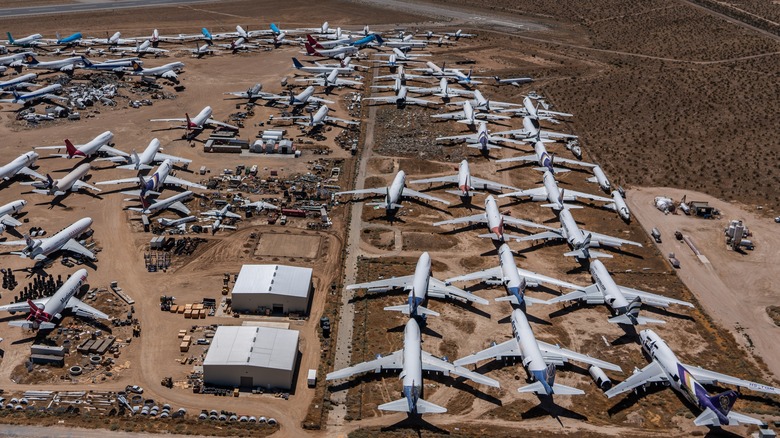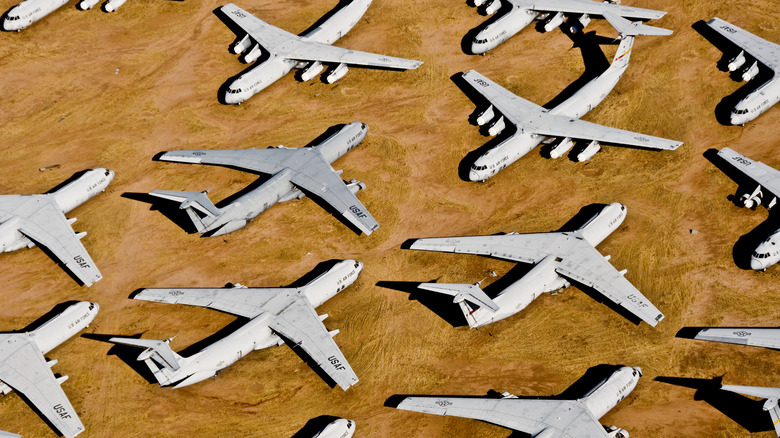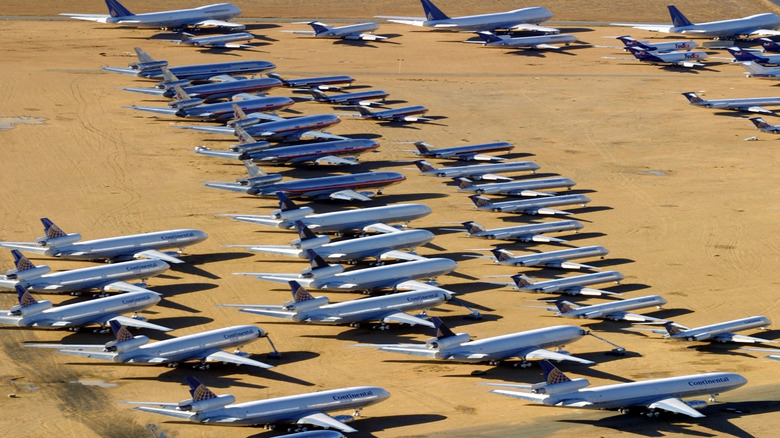Why Are Old Airplanes Stored In The Desert?
The hot scrapyards of Dubai attract a lot of social media attention thanks to the sight of abandoned luxury cars simply gathering dust in massive open areas, often sold at a fraction of their asking price or torn apart for scraps. The situation with commercial airplanes is not too different. But you might be wondering, how airplanes end up in deserts in the first place, and what purpose does it serve? Well, think of it as an analog to the ancient method of storing fruits in dried mud. The objective? Keep stuff from going bad.
For fruits, it's about preserving the water and moisture inside. In the case of airplanes, the goal is to keep corrosion at bay. Airplane boneyards, as they are commonly known, serve as the ideal storage spots due to the weather conditions, and also as the final resting place that keeps the doors open for part scavenging. In fact, with some servicing, aging flyers can also return to active service. We're not talking just about commercial airplanes, but also those that assist with defense and military activities.
Thanks to regeneration efforts, retired combat vehicles such as B-1 Lancer heavy bombers, C-23 Army Sherpas, and B-57 bombers have found a new life in the military ranks and even NASA's weather monitoring duties. Ultimately, it's all about long-term aircraft storage and parts reclamation, which is made possible by the hot and dry desert climate. Interestingly, an erstwhile US Air Force base in Arizona has now turned into the world's largest aircraft boneyard.
How does airplane preservation work?
The whole concept of aircraft in a desert sounds almost absurd. "The views in this open desert land are fascinating and surreal at the same time. Aircraft everywhere you look," Recycling International wrote during a survey of the Pinal Air Park in Arizona. But there's plenty of scientific and technical reasoning behind the concept. Dr. Sonya Brown, an aerospace design expert at the University of New South Wales, highlights that low humidity in the air makes for an ideal spot to store massive machines predominantly made of metals and alloys, as the risk of corrosion is significantly lower.
Moreover, the risk of rain and related environmental factors such as cyclones is reduced. Now, as mentioned above, deserts can be temporary or permanent resting places. During the pandemic, such sites became a hub for storing commercial airplanes. For a short-term resting visit, one needs a site with minimal risk from insects, birds, and other organisms doing damage to the interiors. Thanks to the sparse wildlife and vegetation, desert areas are deemed the best spot for temporary storage, as well.
Another important aspect is the area. Compared to an urban hangar, there is no shortage of space in a desert area. In some desert areas, the terrain is hard and dry, which means the cost of pavement infrastructure further comes down. They're, however, not perfect. Lufthansa had to sell half a dozen A380 carriers at a much lower price after they suffered storm damage during storage.
Is it safe to fly in a desert tourist?
Desert-like remote areas are an ideal spot for storing old aircrafts, or even operational units, due to the friendly climate conditions. At the same time, the cost of land acquisition to offer such facilities is much lower compared to a crowded airport hangar. But there are legitimate concerns about the operational health of such post-storage airplanes.
In 2021, a Sriwijaya Air Boeing 737 crashed minutes after take-off, resulting in the death of over 60 people on the flight. The plane had returned to duty after a nine-month storage spell during the pandemic. However, investigations revealed that the Indonesian transport ministry and the Directorate General of Civil Aviation (DGCA) had cleared it as airworthy following multiple inspections.
Even the European Union Aviation Safety Agency (EASA) highlighted the issue of contaminated air data systems due to long-term parking or storage. "EASA has noticed an alarming trend in the number of reports of unreliable speed and altitude indications during the first flight(s) following the aircraft leaving storage," the agency said.
The situation during the pandemic was unprecedented, triggering the expansion of desert storage facilities for airplanes, but that didn't mean maintenance protocols were ignored. Experts also assure that there are specific check and inspection rules in place, depending on how long an airplane has been sitting in an open or closed storage facility. If certified experts handle these duties, there are no major reasons for concern with flying in an airplane that has been in a desert storage space.


